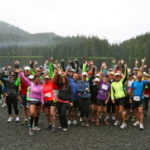What happened? Simply put: WE happened. There was a giant community of runners and walkers who felt ignored by, or worse yet disdained by, the running industry. Many of us felt ashamed by how we looked, how slowly we ran or walked, and by the huge gap between what we were capable of and what we wanted to do.
To be honest, I never really, truly enjoyed running. Or, at least, not in the way that I enjoyed making music, or riding a motorcycle, or even riding a bicycle. Running was a constant battle between the strength of my will and the weakness of my body. When I was foolish enough to allow myself to push past my abilities, I got injured. When I allowed myself to be content with where I was at, I got bored. So running became this cycle of pushing forward and pulling back.
When I began to write about the challenges of being an older, slower runner many of my colleagues at Runner’s World tried to convince me that if I only trained harder, or at least trained smarter, I could run faster and farther. I tried that for a while. It didn’t help. And I came to hate training and running.
No, the truth is I never really liked running. What I REALLY liked were RUNNERS. And there’s the conundrum that many of us face. If we want to be around runners and walkers, if we want to be a part of the community, if we want to participate in the events we have to run. More importantly, for those of us with limited ability, we have to train.
We, the second running generation, began to show up at local high school tracks and running paths and trails. We began, tentatively, to shop at running specialty stores. We began to register for 5Ks, and 10Ks, and marathons. And as our numbers grew we became impossible to ignore.
But many in the industry tried.
I got in to a heated discussion with the race director of a well-known marathon. He wanted to know how he could attract more of the “penguins” to run his race. I asked him what his cut-off time was and he said 4 1/2 hours. When I explained that many of the “penguins”, including me, couldn’t be sure of finishing in 4 1/2 hours he proceeded to explain how dangerous it was to be out on the course that long and how he wasn’t going to be responsible for people getting hurt.
Sadly, at the time, he wasn’t alone. Rather than embracing this new market that we represented, they defended their unwillingness to “allow” us into their community by telling how that it was for our own good. Balderdash.
The first serious recognition of the 2nd running boom came in an article in the New York Times featuring a photo of me wearing a shirt that said: “I’m Slow. I Know. Get Over It.” Shortly after that the book “No Need for Speed” was published. Some in the running community saw this as some kind of manifesto. And maybe it was. YOU needed a voice. I had the platform. I simply tried to represent who we were.
People’s heads began to explode.
Who did we think we were? How DARE we? Didn’t we understand that speed and distance were the only measures of a runners? Didn’t we understand that if we weren’t miserable all the time, and disappointed with our performances, that we weren’t REAL runners.
But we were real runners. And walkers. And run-walkers. And walk-runners. We were athletes. We were just as entitled to call ourselves athletes and they were.
What happened is that we turned the running industry on its head. The Rock ’n’ Roll series exploded. Other events began to increase their finish times. The shoe manufactures began to recognize that the new runners needed different kinds of shoes. NEW shoe companies came in to fill the gap, and the apparel folks began to make clothing that actually looked good on someone who wasn’t skinny.
What happened? The entire running industry figured out that we had money to spend.









Been a while since I checked in. Good to see you’re still writing. Thats very real of you to admit you never liked running. For me, the best part of running workouts are the feelings afterward, the after glow. I think you might know what I’m talking about.
Success as a runner depends a lot on health, being physically able to train, natural athleticism, an intelligent workout regime, and then the mental part: pain tolerance. HIIT track workout are so incredibly painful I get nervous driving to the track. But at least they’re over quickly. No one enjoys pain. But there is good pain and bad pain. Bad pain of injury, and good pain of exhaustion. To some it’s not worth it. I can certainly see why it wouldn’t be worth it to someone who would never be competitive, attaining that reward of a high ranking, top finish, etc… but non competitive ‘penguins’ who have the character and discipline to gut it out and train to be the best they can be are as remarkable as the soaring eagles, in my view. I probably wouldn’t train as hard if I did not have the chance of the rewards of Nat’l and World medals. Then again, it’s about the journey, win or lose. Esse quam videri